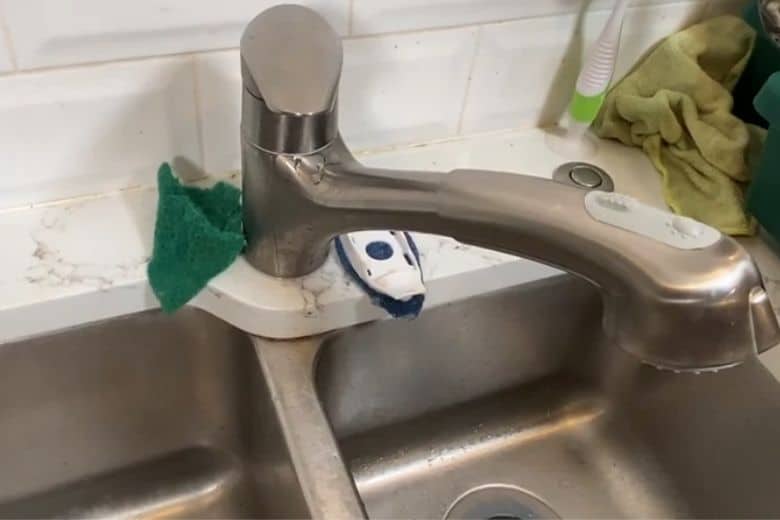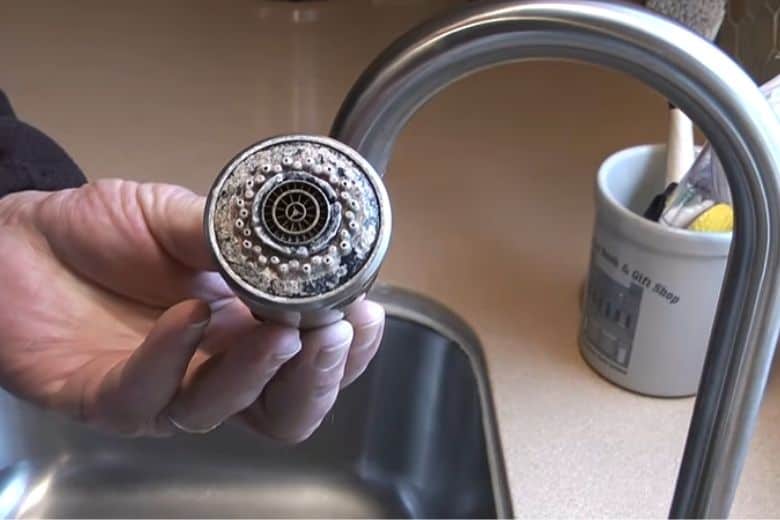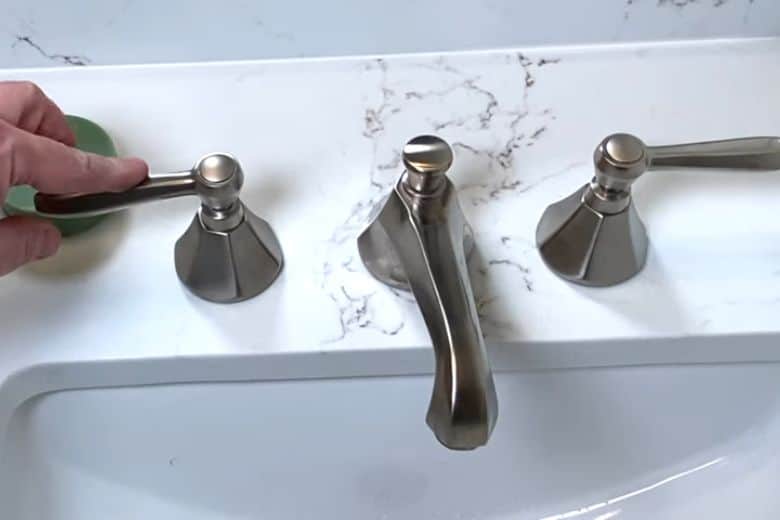A kitchen faucet is designed to last for years without a problem. Most kitchen faucets will easily serve you for 10 to 15 years. Meanwhile, its washer, O-ring, or other parts may get damaged due to rust and corrosion. These damages cause water leakage. On the other side, hard water residues block the aerator and sprayer, stopping the water flow.
Thus, you will need to remove the old kitchen faucet to fix these problems. Unfortunately, people face trouble removing old kitchen faucet since it gets stuck. In most cases, residual development and rust stop the old faucet from moving freely. Thus, you will find it incredibly tough to move the faucet or unscrew the stuck nuts.
You must remove the residues or rust with WD-4- commercial cleaner or penetrating oil. As you apply it to the nuts and faucet handle, it will weaken the rust and residues. Once you have wiped out the weakened rust, you can follow the regular path to remove and clean the kitchen faucet. You may also replace it the same way.
Why Am I Having Trouble Removing Old Kitchen Faucet?
Many homeowners complain that they face problems removing old kitchen faucets. So, what exactly forces the kitchen faucet handle or nuts from moving freely?
The simple answer is rust and residual development. As the old kitchen faucet handle collects dust, food gunk, and grease, eventually, it stops working. Similarly, rust develops around the nuts and exposed portion of the faucet. All these slowly disable the faucet from moving.
Of course, the kitchen faucet is built from stainless steel. It has a rust-resistant rating. Yet, many faucets use poorer quality stainless steel. Also, the copper and aluminum cover aren’t pretty thick. Thus, over the years, they get damaged. After that, continuous flow of water and air work on the damaged parts of the faucet. It slowly grows rust to force the old faucet from moving freely. Thus, you will find it hard to remove the system.
Food residues, gunk, and grease will work similarly. Most of us don’t clean underneath the kitchen faucet. We even ignore washing around the faucet handle and sprayers. Thus, residues build around the nuts, handle, and other parts. Naturally, it stops moving.
However, the real question is how to remove old kitchen faucets?
We will answer the steps to successfully remove the old kitchen faucet in the next few steps.
How to Remove an Old Kitchen Faucet That Is Stuck?
When a kitchen faucet starts leaking or stops working, you need to work with different parts. For instance, you need to unclog the aerator or tighten the nuts. However, old kitchen faucets may get stuck around the handle and nuts. So, you will fail to remove and replace it.
We understand how frustrating it can be. Thus, we have developed the proven steps to remove a stuck faucet in your kitchen sink.
Step 1: Observe the Faucet and Around It
You need to look closely around the kitchen faucet, including its aerator, handle, and nuts underneath the cabinet. It will help you know where the problem lies. Also, try moving the handle to see if it is working properly.
If the handle works properly, move on to the next part. Get a wrench or pliers set to untighten the screw and nuts. It will help you know which nut has got stuck. Once you know where to work, fixing the problem is easier.
Step 2: Spray Commercial Cleaner on The Faucet
When the kitchen faucet gets stuck, you shouldn’t move it forcefully. They may get broken if you apply too much pressure on the faucet handle or nut. Thus, your problem of removing the old faucet will get only worse.
Instead, you should put commercial rust and residual cleaner on the nuts and handle. Also, spray it over the connecting point of the water supply lines and sprayer hose. You can use WD-40 commercial cleaner. It is available in most hardware stores.
It would help to locate the large nuts that hold the kitchen sink and faucet closely. Spray the cleaner on the nuts. Finally, wait for 5 to 10 minutes. It helps the commercial WD-40 cleaner to soften the rust and residues.
Step 3: Wipe Off The Cleaner
Don’t start working with the faucet handle, sprayer, and nuts to remove them immediately. You need to wipe off the WD-40 cleaner at first. Take a piece of clean cloth. Then, carefully wipe off the residual development and rust with it. You may need to repeat applying the commercial rust cleaner and wiping it off multiple times.
Now, you can follow the standard process of removing the faucet to clean it.
Step 4: Turn Off The Water Supply Lines
You must turn off the supply lines whenever you work with any plumbing system. It helps to work without any messes in the workplace. The process follows as follows:
- Turn on both the hot and cold water lines for the faucet. You will find two handles for the modern-day faucets. So, switch them on.
- Now reach underneath the kitchen cabinet. Then, access the shutoff valve for the water lines.
- Once you find the shutoff valves, turn it clockwise. You need to continue turning the valve until it closes fully.
- Within a few seconds, you should see water stopping through the faucet’s hot and cold water lines.
Sometimes the shutoff valve may be damaged. So, it won’t stop the water flow. When it happens, you must shut off your home’s main water supply line.
Step 5: Remove The Water Supply Lines
You now disconnect the water supply lines of the sink faucet from the valve. It is a good thing to replace the old kitchen sink supply hoses.
- Reach underneath the kitchen sink cabinet. If there are any stored items, remove them for the time being.
- Now find the brass nuts connecting the valves with the hose. Turn them counterclockwise with the 6” adjustable wrench.
- Once the nut gets loose, you can remove it and disconnect the water lines. Finally, disconnect the lines from the faucet too. You will need a basin wrench for it.
Sometimes the braided hose will move with the nuts. You need to hold the hose with one hand to stop it from moving. Then you can unscrew the nut with ease.
Step 6: Remove The Sprayer
Many kitchen faucets come with a sprayer attachment. If your faucet model has it, you need to disconnect the sprayer. The sprayer hose includes a quick-connect fitting. It reaches under the sink faucet and snaps there.
You need to keep pinching the sprayer hose fitting. As you pinch it repeatedly, it should become loose. So, you can remove and disconnect it.
Step 7: Remove The Mounting Nuts and Pull Out The Sprayer
Now, it’s time to unscrew the large mounting nut. It holds the kitchen faucet with the sink. The nut is mostly built with plastic. You can twist it counterclockwise to move and disconnect the sink and faucet quickly.
If you find removing the nut with your hands hard, use a basin wrench instead.
Since you have removed all the nuts and attachments for the sink faucet, you can remove them now. At first, it will feel stuck due to years of immobility. Wiggle the faucet and sprayer until it comes out from the base.
You can remove the residues from the faucet to reuse them. Or, you can replace it completely.
Frequently Asked Questions
What size nut holds kitchen faucet?
Answer: A standard kitchen faucet nut will be 1-1/2 inches to 1-3/8 inches. You need to choose the basin wrench carefully so that the nuts fit within it.
How to remove an old kitchen faucet that is stuck?
Answer: You can apply commercial rust cleaner to loosen a stuck faucet nut. Then, wipe off the rust and residues to remove the old faucet.
How do you loosen the nut under the sink faucet?
Answer: You can loosen the nut under the kitchen sink with a 6-inch adjustable wrench. Before it, disconnect the water supply lines from the shutoff valve.
Conclusion
It’s not uncommon to have trouble removing old kitchen faucets. Fortunately, you don’t need to be an expert plumber to remove the stuck sink faucet. You only need to remove the rust and residues from the nut and the faucet handle with commercial rust and residual cleaner. Now, you may easily remove the old faucet following the traditional method.
Paul Newman is a blogger who writes about plumbing and home improvement. Over the past 20 years, I have worked as a plumber. My passion is to share my knowledge and experience with others to improve their homes.




